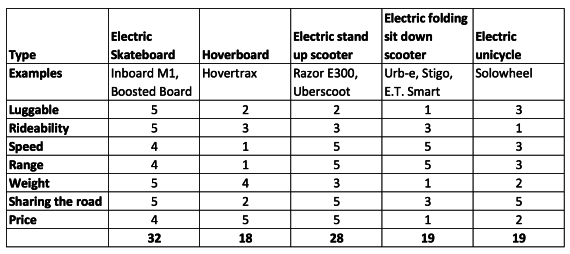Sign up for daily news updates from CleanTechnica on email. Or follow us on Google News!
Seven long years ago — think back before Trump’s presidency, COVID-19, Russia’s criminal invasion of Ukraine, the energy crisis, ChatGPT, Pokemon Go, TikTok, #MeToo, Brexit, #BlackLivesMatter, the Beirut port explosion, the Chinese space station, the death of the last English queen, and many more events — I was interested in electric skateboards and the entire class of electric personal rideable devices. The Hoverboard — a little platform with a couple of wheels on either side which people stood on and moved around with little shifts in body weight — was a huge fad, and it was clearly a near useless toy.
I didn’t think that all electric rideables were toys, in fact I considered the entire space a disruptive urban transportation innovation that was going to radically alter how a lot of things and people moved around cities. These weren’t electric bikes, by the way, but devices that had nothing but electric motors and batteries and usually not even seats. I put electric bikes in a different category, which is arguable and justifiable, but there is clear overlap. They are huge too, of course.
But I thought electric skateboards would dominate the rideables space, not electric scooters. I was wrong, although electric skateboards are distinctly second in the class of vehicles over everything else.
Being me, I put together a set of factors for comparing the space, gave them ratings from 1 to 5, and added up the scores to get some sense of what was mostly likely to be a big thing. The assessment suggested that electric skateboards and standup electric scooters were going to be the big winners in the space.
Brief aside: At the time I thought that weighted comparison matrices were better than straightforward ones like this one. I was vaguely guilty that I didn’t weight the factors. However, Daniel Kahneman’s Noise: A Flaw in Human Judgment, co-authored with Olivier Sibony and Cass Sunstein, makes it very clear that all weighting of factors in assessments like this does is to introduce statistical noise that means signal is lost. A shorter list of simply rated factors is much better than a longer list of more nuanced factors that are weighted when it comes to decision making. Strongly recommended reading for people wanting to make better decisions.
Lesson? Don’t weight evaluation matrices.
That turned out to be true. E-skateboards and scooters dominate this space globally. But e-skateboards are nowhere near as dominant as e-scooters. My assessment was simply wrong there. Why?
Well, back to Noise. One of the things that I got wrong was to separate luggability and weight into two factors and score them separately. A single luggability factor would have introduced less noise. Most electric skateboards are more luggable and lighter than most standup scooters, but I inadvertently added weight to this metric. The scoring would have been even closer without this mistake on my part.
Lesson? See how many factors you can merge after you make your list, not how many you can add.
There’s a bit of a question in my mind about the value of luggability at all in retrospect. My context at that point was as someone who hadn’t owned a car at all for four years and had used transit and walking as my dominant forms of transportation in something like seven cities on three or four continents over the previous four years. I had had a couple of last mile devices in Singapore that I rode to the subway at one end, and rode to my destination at the other, tucking them between my feet on the train. My context was keeping the same device with me.
I missed entirely the rise of shareable electric rideables, even though I had share-bike passes for two different cities (and transit passes for four cities) at the time. Extending that model into this space didn’t connect for me. To be fair to myself, the assessment pre-dated Lime and similar dockless scooter and bike sharing services, but still it’s so obvious in retrospect that I feel I should have known. However, I felt that about the first introduction of email in a browser with Hotmail too, and I didn’t think of that before it appeared.
Why does this shareable scooter model matter for luggability? Well, you never have to lug share scooters anywhere. You walk out of wherever you are, find the closest one (usually really close in downtown areas where they thrive) and park them (hopefully not blocking sidewalks) at the other end and walk away. You don’t have to carry them down into the subway or up the stairs to apartments, or to lift them into and out of trunks. The last-mile vehicles turning into share vehicles made the entire question of luggability one of questionable merit. And lots of people live in places accessible to things with wheels which have elevators if they have multiple floors, requiring at most a curb to get over.
If I were to redo the matrix today, I’d at minimum merge luggability and weight, maybe getting rid of the factor entirely, and add a Shareability factor. E-scooters are great for share systems, but e-skateboards aren’t at all. Why not? Well, in addition to the small number of people who could ride them, the skateboard requires a wireless hand controller, which is tiny, lightweight and would disappear as my personal one has. There are a couple of ways around that, but they are much less convenient than just sharing e-scooters.
Lesson? Stay humble. There’s always something you don’t know.
What else? What was the definition of rideability?
How easy is the device to learn? Are there barriers to entry? How comfortable is it for longer distances?
This is a place where bias crept in for sure. I have owned a couple of push skateboards and a push scooter, but was considering getting an electric skateboard. I hadn’t ridden either an electric skateboard or scooter yet, which I was open to about seven years ago, but had ridden other electric rideables.
I’ve now owned an electric skateboard and ridden electric share scooters in at least four cities through Uber and other share services. It can’t be overstated how deeply easy it is to ride electric scooters compared to almost everything else, including electric skateboards. The much bigger, inflated wheels on e-scooters are much more comfortable across far more surfaces. Traction in the wet is better and there is no worry about road spray because they have fenders. And you can carve turns with them as well, and put things between your feet on the platform. They just are vastly easier to use and more rideable for people who didn’t have skateboards when they were kids, and for people who did as well.
My ratings for rideability were completely the wrong way around. Because I was thinking of getting an electric skateboard, bias crept in.
Lesson? Check your biases.
Another factor for rideability is hill climbing. I’m 90 kg when I’m lean, and my electric self-balancing unicycle and electric skateboard struggled up Vancouver’s hills, never mind really steep cities like San Francisco or Auckland. Modern self-balancing unicycles wouldn’t have that problem because they are beasts, often with suspension and capable of traveling at speeds up to 100 kph. (There’s a reason why the ones I frequently see in Vancouver are ridden by people with full face helmets and motocross armor.)
Scooters aren’t designed to be picked up and carried as most skateboards are, so weight isn’t a factor, hence batteries and power controllers can be beefier. And the electric motors aren’t constrained by the in-wheel form factor to be lower torque, so there’s more ooomph there as well. All this means is that right now, it’s much easier to go up steeper hills with more weight on a scooter than on a skateboard. In fact, couples on scooters are pretty common.
What else? Well, Inboard and Boosted are both interesting case studies in this space. Both were providing electric skateboards at the time, with Boosted being the leader with its external motor and belt drive to the wheel system providing amazing torque. I thought that in-wheel motors would dominate the space, with the Inboard M1 being the clear successor to Boosted.
How are the two firms doing? Inboard abandoned skateboards entirely to make fleet scooters. Boosted went out of business.
All I got right there was in-wheel motors dominating the electric skateboard space. My eventual electric skateboard, purchased from Chinese-firm Verreal because it was cheap and I knew I was buying a toy for myself, has them. Every road skateboard I’ve seen that isn’t an off-road board running on pavement has them. They’re just better.
What I also got right was the big picture. Tiny personal electric transportation devices are dominating urban areas globally. I’ve been in eight cities on three continents in the last year and they were everywhere in the downtown cores. Scooter share systems were in six of the eight cities (and I’m unhappy that there isn’t one in Vancouver where I live). E-scooters, e-skateboards, and e-unicycles share bike paths with e-bikes and regular bikes, and virtually all food delivery services are now delivering with electric rideables or e-bikes.
That’s great news, as they are absurdly efficient at moving people and small loads through urban areas without causing congestion, without noise, without pollution and without greenhouse gas emissions. Along with electric bikes which are also silently disrupting urban transportation, they are decarbonizing and depolluting urban transportation and taking a load off straining transit systems in cities globally.
Have a tip for CleanTechnica? Want to advertise? Want to suggest a guest for our CleanTech Talk podcast? Contact us here.
EV Obsession Daily!
I don’t like paywalls. You don’t like paywalls. Who likes paywalls? Here at CleanTechnica, we implemented a limited paywall for a while, but it always felt wrong — and it was always tough to decide what we should put behind there. In theory, your most exclusive and best content goes behind a paywall. But then fewer people read it!! So, we’ve decided to completely nix paywalls here at CleanTechnica. But…
Thank you!
Tesla Sales in 2023, 2024, and 2030
CleanTechnica uses affiliate links. See our policy here.





